Brachoria
The Appalachian Mimic Millipedes
Paul Marek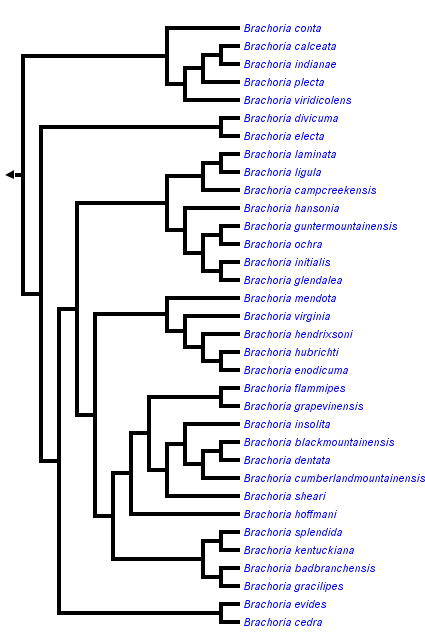


This tree diagram shows the relationships between several groups of organisms.
The root of the current tree connects the organisms featured in this tree to their containing group and the rest of the Tree of Life. The basal branching point in the tree represents the ancestor of the other groups in the tree. This ancestor diversified over time into several descendent subgroups, which are represented as internal nodes and terminal taxa to the right.

You can click on the root to travel down the Tree of Life all the way to the root of all Life, and you can click on the names of descendent subgroups to travel up the Tree of Life all the way to individual species.
For more information on ToL tree formatting, please see Interpreting the Tree or Classification. To learn more about phylogenetic trees, please visit our Phylogenetic Biology pages.
close boxIntroduction
The apheloriine millipede genus Brachoria comprises 34 species distributed throughout the southeastern U.S. Appalachian Mountains. Brachoria is the third largest (in terms of species) millipede genus in the U.S., Cleidogona and Pseudotremia are the largest with 80 and 47. Members of this genus are blind and produce cyanide (like all millipedes in the order Polydesmida). They are large (4-6 cm in length) and display conspicuous aposematic coloration in yellow, red, orange and violet. Many Brachoria species participate in Müllerian mimicry rings with co-occurring Apheloriini, in particular with species in the genus Apheloria.

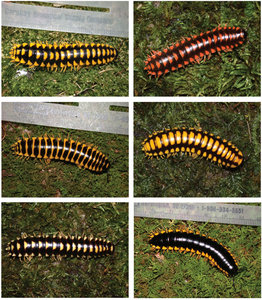
Considerable color and pattern variation between morphs of a single species, Brachoria dentata. © Paul Marek
Characteristics
- Large (4-6 cm in length), broad, “flat-backed” millipedes. Bright aposematic coloration in yellow, orange, red, violet that commonly mimics other sympatric apheloriine genera. Brachoria individuals frequently mimic the yellow and black spots or alternating yellow and black bands of Apheloria.
- Collum with carinae present on anterolateral margins, absent medially; carinae rarely completely absent.
- Distinct cingulum present (cg).
Other apheloriine genera lack a cingulum, except for individuals in the genus Appalachioria, see below for distinguishing characters between individuals in the genera Brachoria and Appalachioria.
- Acropodite occasionally bulky (in 10 out of 34 species); width greater than tibia on leg pair nine (species with bulky gonopods: B. splendida, B. blackmountainensis, B. calceata, B. campcreekensis, B. cumberlandmountainensis, B. kentuckiana, B. laminata, B. plecta, B. sheari, and B. viridicolens).

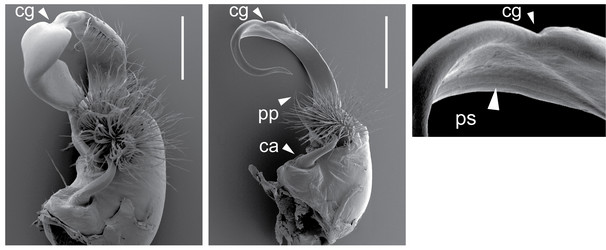
Scanning electron micrographs of Brachoria left male gonopods, labeled with key features (ca = cannula, cg = cingulum, pp = prefemoral process, ps = prostatic groove), left: bulky gonopod from Brachoria splendida, middle: narrow gonopod from Brachoria hendrixsoni, right: acropodite from B. hendrixsoni, magnified view of cingulum and prostatic groove (scale bars = 1 mm). © 2010 Paul Marek

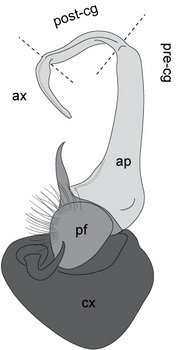
Illustration of Brachoria initialis left male gonopod, color-coded by region. The gonopod comprises the acropodite (light gray), prefemur (medium gray), and coxa (dark gray). Dashed lines indicate junctions between (moving distally from the prefemur) the precingular region, postcingular region, and apex (ap = acropodite, ax = acropodite apex, cx = coxa, pf = prefemur, post-cg = post-cingular region of acropodite, pre-cg = precingular region of acropodite). © 2010 Paul Marek
*Note: Individuals of Brachoria may be confused with Apheloria and Appalachioria, but can be distinguished from Apheloria by the presence of the following characters (viewed with a 20X loupe): Acropodite with cingulum (cg). Acropodite, when viewed ventrally C- or D-shaped, acropodal apex not coiled, or overlapping prefemoral region, not circular. Individuals of Brachoria can be distinguished from Appalachioria by the presence of the following characters (viewed with a 20X loupe): Collum with carinae present on anterolateral margins, absent medially. Caudolateral corners of paranota usually rounded cephalically on anterior body rings (1 – 4) and acute, projecting caudally (beyond paranotal caudal edge) throughout posterior body rings (11 – 19); not rounded on all segments (1 – 19) as in Appalachioria.
Habitat
Brachoria are predominately found in Appalachian mixed mesophytic deciduous forests (B. cedra often occur in cedar glades) beneath decomposing leaf material on the forest floor. Individuals are less frequently encountered in Tsuga canadensis and Rhododendron coves.
Distribution
Predominately distributed in the Valley and Ridge and Cumberland Plateau provinces from southern West Virginia to northeastern Kentucky, south to eastern Tennessee and southwestern Virginia. The range of the genus extends into the historically unglaciated southeastern corner of Indiana, northeastern Mississippi and Alabama, and northwestern Georgia. The species B. initialis is broadly distributed in the coastal plain in Alabama, Mississippi and Louisiana (extending west of the Mississippi River).
References
Hoffman R.L. 1971. Millipeds of the genus Brachoria from southwestern Virginia (Polydesmida: Xystodesmidae). Radford Rev. 25: 83–99.
Hoffman R.L. 1971. Millipeds of the genus Brachoria from southwestern Virginia (Polydesmida: Xystodesmidae). Rad. Rev. 25: 83-99.
Keeton W.T. 1959. A revision of the millipede genus Brachoria (Polydesmida: Xystodesmidae). Proc. U.S. Nat. Mus. 109: 1-58.
Keeton W.T. 1965. Descriptions of three new species of Brachoria, with notes on established species (Diplopoda, Polydesmida, Xystodesmidae). Proc. Biol. Soc. Wash. 78: 225-240.
Marek P.E., Bond J.E. 2006. Phylogenetic systematics of the colorful, cyanide-producing millipedes of Appalachia (Polydesmida, Xystodesmidae, Apheloriini) using a total evidence Bayesian approach. Mol. Phylogenet. Evol. 41: 704–729.
Marek P.E., Bond J.E. 2007. A reassessment of apheloriine millipede phylogeny: additional taxa, Bayesian inference, and direct optimization (Polydesmida: Xystodesmidae). Zootaxa 1610: 27–39.
Marek P.E., Bond J.E. 2009. A Müllerian mimicry ring in Appalachian millipedes. Proc. Nat. Acad. Sci. USA 106: 9755-9760.
Marek P.E. 2010. A revision of the Appalachian millipede genus Brachoria Chamberlin, 1939 (Polydesmida: Xystodesmidae: Apheloriini). Zool. J. Linn. Soc. 159: 817-889.
Shelley R.M. 1979. The status of Sigmoria gracilipes Chamberlin, with remarks on the milliped genus Brachoria (Polydesmida: Xystodesmidae). Fla. Entomol. 62: 220–223.
Title Illustrations

| Scientific Name | Brachoria cedra |
|---|---|
| Location | USA, Virginia, Lee Co. |
| Reference | Marek P.E. 2010. A revision of the Appalachian millipede genus Brachoria Chamberlin, 1939 (Polydesmida: Xystodesmidae: Apheloriini). Zool. J. Linn. Soc. 159: 817-889. |
| Specimen Condition | Live Specimen |
| Sex | m |
| Life Cycle Stage | adult |
| View | dorsal |
| Collection | FMNH |
| Collector | Paul Marek |
| Image Use |
 This media file is licensed under the Creative Commons Attribution-NonCommercial License - Version 3.0. This media file is licensed under the Creative Commons Attribution-NonCommercial License - Version 3.0.
|
| Copyright |
© Paul Marek

|
| Scientific Name | Brachoria mendota |
|---|---|
| Location | USA, Tennessee, Jefferson Co. |
| Reference | Marek P.E. 2010. A revision of the Appalachian millipede genus Brachoria Chamberlin, 1939 (Polydesmida: Xystodesmidae: Apheloriini). Zool. J. Linn. Soc. 159: 817-889. |
| Specimen Condition | Live Specimen |
| Sex | m |
| Life Cycle Stage | adult |
| View | dorsal |
| Collection | FMNH |
| Collector | Paul Marek |
| Image Use |
 This media file is licensed under the Creative Commons Attribution-NonCommercial License - Version 3.0. This media file is licensed under the Creative Commons Attribution-NonCommercial License - Version 3.0.
|
| Copyright |
© Paul Marek

|
| Scientific Name | Brachoria hubrichti |
|---|---|
| Location | USA, Tennessee, Warren Co. |
| Reference | Marek P.E. 2010. A revision of the Appalachian millipede genus Brachoria Chamberlin, 1939 (Polydesmida: Xystodesmidae: Apheloriini). Zool. J. Linn. Soc. 159: 817-889. |
| Specimen Condition | Live Specimen |
| Sex | m |
| Life Cycle Stage | adult |
| View | dorsal |
| Collection | FMNH |
| Collector | Paul Marek |
| Image Use |
 This media file is licensed under the Creative Commons Attribution-NonCommercial License - Version 3.0. This media file is licensed under the Creative Commons Attribution-NonCommercial License - Version 3.0.
|
| Copyright |
© Paul Marek

|
| Scientific Name | Brachoria campcreekensis |
|---|---|
| Location | USA, West Virginia, Mercer Co. |
| Reference | Marek P.E. 2010. A revision of the Appalachian millipede genus Brachoria Chamberlin, 1939 (Polydesmida: Xystodesmidae: Apheloriini). Zool. J. Linn. Soc. 159: 817-889. |
| Specimen Condition | Live Specimen |
| Sex | m |
| Life Cycle Stage | adult |
| View | dorsal |
| Collection | FMNH |
| Type | paratype |
| Collector | Paul Marek |
| Image Use |
 This media file is licensed under the Creative Commons Attribution-NonCommercial License - Version 3.0. This media file is licensed under the Creative Commons Attribution-NonCommercial License - Version 3.0.
|
| Copyright |
© Paul Marek

|
About This Page
Work on the millipede Tree of Life pages was supported by a U.S. National Science Foundation Doctoral Dissertation Improvement Grant to Paul Marek and Jason Bond (DEB 0607996) and a Partnerships for Enhancing Expertise in Taxonomy Grant to Petra Sierwald, Jason Bond, and William Shear (DEB 0529715).
Paul Marek

Virginia Polytechnic Institute and State University
Correspondence regarding this page should be directed to Paul Marek at
Page copyright © 2010 Paul Marek
 Page: Tree of Life
Brachoria . The Appalachian Mimic Millipedes.
Authored by
Paul Marek.
The TEXT of this page is licensed under the
Creative Commons Attribution-NonCommercial License - Version 3.0. Note that images and other media
featured on this page are each governed by their own license, and they may or may not be available
for reuse. Click on an image or a media link to access the media data window, which provides the
relevant licensing information. For the general terms and conditions of ToL material reuse and
redistribution, please see the Tree of Life Copyright
Policies.
Page: Tree of Life
Brachoria . The Appalachian Mimic Millipedes.
Authored by
Paul Marek.
The TEXT of this page is licensed under the
Creative Commons Attribution-NonCommercial License - Version 3.0. Note that images and other media
featured on this page are each governed by their own license, and they may or may not be available
for reuse. Click on an image or a media link to access the media data window, which provides the
relevant licensing information. For the general terms and conditions of ToL material reuse and
redistribution, please see the Tree of Life Copyright
Policies.
- First online 16 September 2010
- Content changed 16 September 2010
Citing this page:
Marek, Paul. 2010. Brachoria . The Appalachian Mimic Millipedes. Version 16 September 2010 (under construction). http://tolweb.org/Brachoria/144209/2010.09.16 in The Tree of Life Web Project, http://tolweb.org/




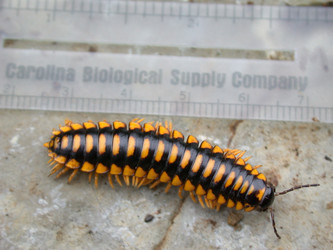
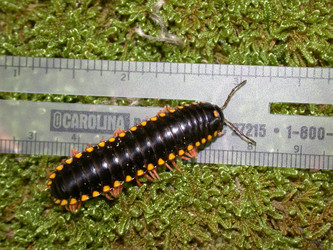
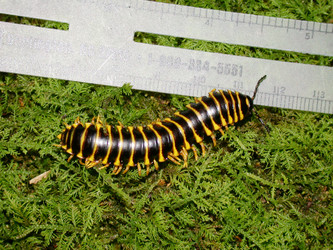




 Go to quick links
Go to quick search
Go to navigation for this section of the ToL site
Go to detailed links for the ToL site
Go to quick links
Go to quick search
Go to navigation for this section of the ToL site
Go to detailed links for the ToL site